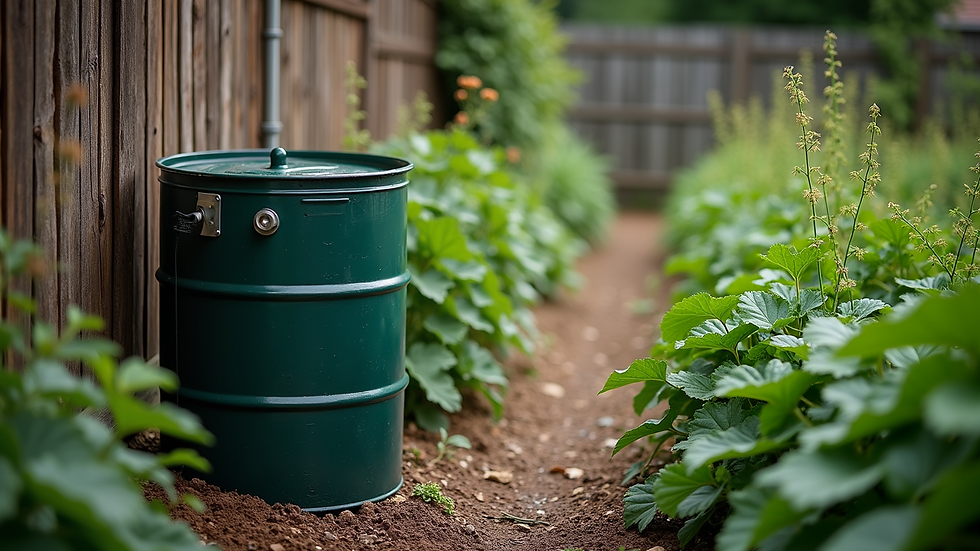Sustainable Gardening: Practices You Can Start Today
- bardneymanor
- Aug 4
- 3 min read
Gardening is a rewarding hobby that connects us with nature. However, traditional gardening methods can sometimes harm the environment. By adopting eco-friendly gardening techniques, you can create a beautiful garden that supports biodiversity, conserves resources, and reduces waste. This guide will explore practical ways to start sustainable gardening today, helping you nurture your green space responsibly.
Embracing Eco-Friendly Gardening for a Greener Future
Eco-friendly gardening focuses on working with nature rather than against it. It involves using natural resources wisely and avoiding harmful chemicals. This approach benefits the environment, wildlife, and your garden’s health.
To begin, consider the following eco-friendly gardening tips:
Choose native plants: Native species are adapted to your local climate and soil. They require less water and care, and they provide food and shelter for local wildlife.
Use organic compost: Compost enriches soil naturally, improving its structure and fertility without synthetic fertilizers.
Collect rainwater: Installing rain barrels helps conserve water by capturing rainfall for garden use.
Avoid chemical pesticides: Use natural pest control methods like companion planting or introducing beneficial insects.
Practice crop rotation: Changing plant locations each season prevents soil depletion and reduces pests.
By integrating these methods, you create a thriving garden that supports the ecosystem and reduces your environmental footprint.

How to Start Sustainable Gardening Practices in Your Backyard
Starting sustainable gardening practices can be simple and rewarding. Here are actionable steps to help you get going:
Assess your garden space
Observe sunlight patterns, soil type, and existing plants. This information helps you select suitable plants and design your garden efficiently.
Prepare the soil naturally
Avoid chemical fertilizers. Instead, add organic matter like compost, leaf mould, or well-rotted manure to improve soil health.
Plant with purpose
Select drought-tolerant and pest-resistant plants. Group plants with similar water and sunlight needs together to conserve resources.
Mulch to retain moisture
Apply a layer of organic mulch such as bark chips or straw around plants. Mulching reduces water evaporation and suppresses weeds.
Create habitats for wildlife
Include bird feeders, insect hotels, and water sources to encourage beneficial creatures that help control pests and pollinate plants.
Use sustainable gardening tools
Opt for manual tools or energy-efficient electric equipment to reduce your carbon footprint.
By following these steps, you can transform your garden into a sustainable oasis that flourishes year-round.

What are some sustainable environmental practices?
Sustainable environmental practices in gardening focus on conserving resources and protecting ecosystems. Here are some key practices to consider:
Water conservation: Use drip irrigation or soaker hoses to deliver water directly to plant roots, reducing waste. Water early in the morning or late in the evening to minimize evaporation.
Soil preservation: Avoid tilling too deeply, which can disrupt soil structure and microorganisms. Instead, use no-dig gardening methods to maintain soil health.
Waste reduction: Compost kitchen scraps and garden waste instead of sending them to landfill. This reduces methane emissions and returns nutrients to the soil.
Biodiversity promotion: Plant a variety of species to attract different pollinators and beneficial insects. Avoid monocultures that can lead to pest outbreaks.
Energy efficiency: Use solar-powered garden lights and tools where possible to reduce reliance on fossil fuels.
Implementing these practices helps create a resilient garden that supports the environment and reduces your ecological impact.

Tips for Maintaining a Sustainable Garden Year-Round
Maintaining a sustainable garden requires ongoing care and attention. Here are some tips to keep your garden healthy and eco-friendly throughout the seasons:
Seasonal planting: Grow seasonal vegetables and flowers to match natural cycles, reducing the need for artificial inputs.
Regular soil testing: Check soil pH and nutrient levels to adjust amendments naturally and avoid over-fertilizing.
Integrated pest management: Monitor plants regularly for pests and diseases. Use natural remedies like neem oil or insecticidal soap when needed.
Prune responsibly: Remove dead or diseased branches to promote healthy growth and prevent the spread of pests.
Seed saving: Collect seeds from your plants to grow next season, preserving heirloom varieties and reducing seed costs.
By following these tips, you ensure your garden remains productive and sustainable year after year.
Bringing It All Together: Your Path to Sustainable Gardening
Starting with small changes can lead to big environmental benefits. By adopting sustainable gardening practices, you contribute to a healthier planet while enjoying a vibrant, thriving garden. Remember, every effort counts - from planting native species to conserving water and reducing waste.
Gardening sustainably is not just about what you grow but how you care for your garden. With patience and dedication, your eco-friendly garden will become a sanctuary for wildlife and a source of joy for you.
Take the first step today and watch your garden flourish in harmony with nature. Happy gardening!




Comments